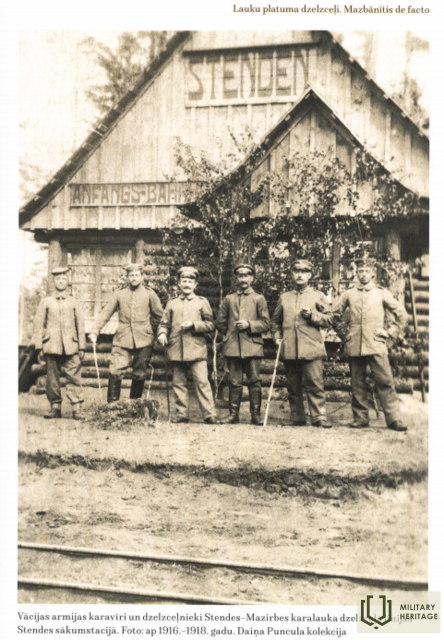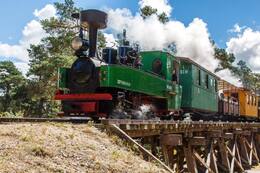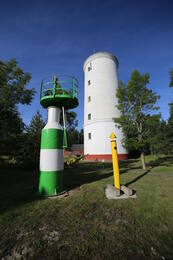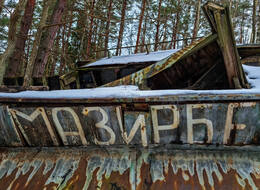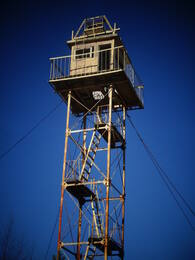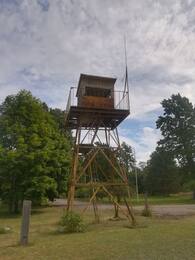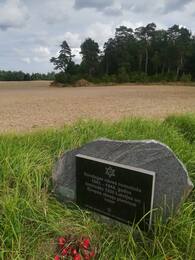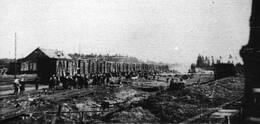Svarbi Stendės stoties vieta Karalausko geležinkelio tinkle
Irbės sąsiaurio rajono mūšio lauko geležinkelių pagrindinė užduotis buvo aprūpinti Vokietijos armijos pakrantės gynybos pozicijas patrankomis ir amunicija.
Šie lauko geležinkeliai, nutiesti išimtinai kariniams tikslams, sujungė tris svarbiausius švyturius, kurie buvo Ovišuose, Miķeļtornyje ir Šlīterėje.
Geležinkelio linija Ventspilis–Mazirbė, taip pat Stendės–Dundagos atšaka iki Mazirbės su atšaka į Pitragą buvo skirta tik karinėms-strateginėms reikmėms. Šių linijų statybos metu ir vėliau iš šio regiono buvo evakuoti visi civiliai gyventojai. Tačiau nepaisant to, keleivių vežimas buvo vykdomas ir Pirmojo pasaulinio karo metu.
Toms Altbergs, Andris Biedriņš, Dainis Punculs, Artūrs Tukišs "RURAL WIDTH RAILWAYS" Mazbānītis de facto
Susijusi laiko juosta
Susijusios temos
Susijusios vietos
Siaurojo geležinkelio traukinukas „Mazbānītis“ Ventspilio Pajūrio muziejuje po atviru dangumi
Ventspilio Pajūrio muziejuje po atviru dangumi galite pasivažinėti dviem siaurojo geležinkelio linijomis su traukinuku „Mazbānītis“. Žiedinė linija yra 1,4 km, o kalnų linija – 3 km. „Mazbānītis“ – tai lokomotyvas, kuris 1916–1963 m. 600 mm siaurojo geležinkelio bėgiais vežė keleivius ir krovinius. Tai Pirmojo pasaulinio karo karinės istorijos palikimas, kuris kadaise atliko svarbų vaidmenį šiaurinės Kuržemės kultūriniame ir ekonominiame vystymesi, jungdamas gyvenvietes ir suteikdamas naujų darbo vietų.
Didelio 600 mm siaurojo geležinkelio tinklo statyba daugiausia siejama su Pirmuoju pasauliniu karu, kai 1916 m. Vokietijos armija okupuotoje Latvijos teritorijoje pradėjo kelių vadinamųjų karinių lauko geležinkelių (vok. Heeresfeldbahn) statybą. Šie geležinkeliai galėjo būti greitai nutiesti, išardyti ir perkelti į kitą fronto liniją. Latvijos siaurojo geležinkelio tinklas buvo naudojamas ir Antrojo pasaulinio karo metu. Beveik 60 metų siaurasis geležinkelis buvo vienintelė saugi priemonė keleiviams, įvairiems žemės ūkio produktams ir medienai gabenti į miestus tiek žiemą, tiek vasarą.
Mazbānīčio takas Šiaurės Kuržemėje
Mažbānīte Šiaurės Kuržemėje vadinamas traukinys, kuris 1916–1963 m. 600 mm pločio siaurojo geležinkelio bėgiais vežė keleivius ir krovinius. Tai Pirmojo pasaulinio karo laikų karinės istorijos palikimas, kuris kadaise atliko svarbų vaidmenį visos Šiaurės Kuržems, o ypač Lyvių žvejų kaimų, kultūriniam ir ekonominiam klestėjimui, užtikrindamas susisiekimą tarp gyvenviečių ir suteikdamas darbo vietų.
Gamtos takas veda iš Mazirbės į Sīkragą buvusiu Stendės–Ventspilio siaurojo geležinkelio keliu, arba, kaip sako vietiniai – mazbānīšos keliu. Geležinkelio tiesimas pradėtas 1916 m. ir veikė iki 1963 m. Siaurojo geležinkelio linija jungė Ventspilio uostamiestį su pakrantės žvejų kaimais, Dundagu ir dideliu geležinkelio mazgu Stendėje, taip prisidėdama prie regiono ekonominio ir kultūrinio klestėjimo tarpukariu.
Sovietų Sąjungos laikais pakrantė buvo „Uždara zona“, todėl pakrantės kaimai buvo ekonomiškai izoliuoti, o jų gyventojų skaičius mažėjo. Naujai pastatytų slaptų karinių objektų buvimas taip pat prisidėjo prie to, kad septintajame dešimtmetyje buvo sustabdytas geležinkelių eismas.
Takas turi trumpą 15 km ilgio žiedą ir ilgą 19 km ilgio žiedą.
GPX žemėlapis pasiekiamas čia:
https://www.kurzemesregions.lv/projekti/turisms/unigreen/dabas-takas/mazbanisa-dabas-taka/
Oviši švyturys ir sovietinė pasienio apsauga
Ovišų švyturys yra Tārgalės valsčiuje, Ovišų kaime, Kuržemės pakrantėje. Jis buvo pastatytas 1814 m. ir yra seniausias švyturys Latvijoje. Ovišų švyturio bokšto aukštis yra 37 m. Švyturys yra dvigubo cilindro konstrukcijos: jo skersmuo yra 11,5 m, tačiau akmeninėje sienoje yra antras bokštas, kurio skersmuo yra 3,5 m. Tokie dvigubo cilindro švyturiai XVIII–XIX a. Europoje taip pat buvo naudojami kaip gynybiniai statiniai priešo atakų atveju. Ovišų švyturio muziejus laikomas didžiausia švyturio įrangos ir jūrų navigacijos daiktų kolekcija tarp visų Latvijos švyturių muziejų. Geru oru iš Ovišų švyturio galima pamatyti Irbės švyturį.
Antrojo pasaulinio karo pabaigoje netoli Ovišų švyturio buvo įsikūręs Vokietijos armijos Bemingerio bataliono štabas kartu su 530-osios jūrų artilerijos divizijos 4-ąja baterija su keliais priešlėktuviniais pabūklais. Pasakojama, kad švyturio papėdėje buvo radijo krypties ieškiklis ir infraraudonųjų spindulių aptikimo stotis „Donau Gerät“. Netoli švyturio kadaise buvo įsikūręs sovietinis pasienio apsaugos postas, tačiau nė vienas sovietmečio pastatas neišliko. Ovišų stoties pastatas vis dar yra švyturio teritorijoje.
Mazirbės laivų kapinės
Mazirbė, istoriškai vadinama didžiausiu lyvių centru, žymi tuo, kad čia yra vienintelės žvejų laivų kapinės Latvijos pakrantėje. Jos buvo įkurtos septintajame dešimtmetyje, o paskutinės valtys buvo atgabentos 1976 m. Valtys čia atsidūrė tiek dėl žvejybos apribojimų, tiek dėl jų amžiaus.
Šiandien Mazirbėje yra mažiau nei dešimt žvejybinių laivų nuolaužų, tačiau istoriškai jų buvo daug daugiau. Laivai buvo palaidoti ir kituose pajūrio kaimuose, tačiau būtent Mazirbės laivų kapinėse tai šiandien labiausiai akivaizdu.
Mazirbės laivų kapinės yra vienintelės tokio pobūdžio Latvijos pajūryje.
Mazirbės pasienio apsaugos bokštas
Sovietinis pasienio apsaugos postas buvo įsikūręs pastate, kuriame anksčiau buvo jūreivystės mokykla, o šalia jo yra gerai išsilaikęs sovietinis pasienio sargybos bokštas. Antrasis sargybos bokštas yra tiesiai ant kranto, šalia automobilių stovėjimo aikštelės. Šie sargybos bokštai primena sovietų okupaciją ir laikus, kai Mazirbė buvo uždara pasienio zona, o civiliai gyventojai krante buvo leidžiami tik specialiai tam skirtose vietose ir tik dienos metu. Šis pasienio sargybos bokštas yra vienas geriausiai išsilaikiusių tokio tipo objektų Latvijos pakrantėje. Tačiau į jį lipti pavojinga.
Mazirbės jūreivystės mokykla
Šiame komplekse esantis sovietinis pasienio apsaugos bokštas yra vienas geriausiai išsilaikiusių tokio tipo Latvijos pakrantėje. Deja, pastatų būklė prasta, toje vietoje yra šautuvų užtaisymo/iškrovimo aikštelė, taip pat išgelbėta įvaža ir apkasų fragmentai.
Pakrančių apsaugos postas buvo įsikūręs buvusiame Jūrų mokyklos pastate. Posovietiniu laikotarpiu dalyje pastatų buvo siūlomas apgyvendinimas.
Antrasis sovietinės pasienio apsaugos bokštas yra apie 400 m nuo paplūdimio, bet, deja, yra apgriuvusios būklės. Tačiau Mazirbės laivų kapinės yra ne toliau kaip 500 m nuo paplūdimio bokšto Sīkrago kryptimi.
Stendės geležinkelio stotis siaurojo geležinkelio tinkle ir atminimo akmuo tremtims
Geležinkelio linija Ventspilis–Mazirbė, taip pat Stendės–Dundagos pratęsimas iki Mazirbės su atšaka iki Pitragės buvo skirti tik strateginėms karinėms reikmėms. Šių linijų statybos metu ir vėliau iš regiono buvo evakuoti visi civiliai gyventojai. Pagrindinė karinių geležinkelių užduotis Irbės sąsiaurio rajone buvo aprūpinti Vokietijos armijos pakrantės gynybos pozicijas pabūklais ir amunicija.
Šie tik kariniams tikslams skirti kariniai geležinkeliai taip pat sujungė tris svarbiausius švyturius, esančius Ovišuose, Mikeltornyje ir Šlīterėje.
Nepaisant to, keleivių pervežimas buvo vykdomas jau Pirmojo pasaulinio karo metais.
Stendės geležinkelio stotyje yra atminimo akmuo (1989 m.) 1941 ir 1949 m. deportuotiems latviams.
1919 m. spalio 30 d. Stendės geležinkelio stotį užėmė Bermonto kariuomenė. Lapkričio 17 d. Latvijos armijos kareiviai, vadovaujami K. Šnēbergo, puolė stotį, nuvarydami vežimą su ginklais, karo medžiagomis ir grūdais. Už šiuos mūšius ordino ordinu buvo apdovanoti 6 kareiviai: K. Bumovskis (1891–1976), P. Strautiņš (1883–1969), R. Plotnieks (1891–1965), E. Jansons (1894–1977).




